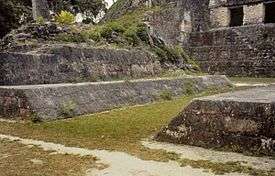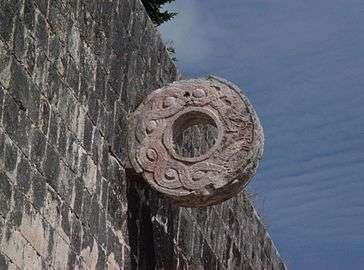Maya Ballgame
Maya Ballgame, which is a branch of the Mesoamerican Ballgame, is an sport event that was played throughout the Maya civilization. The Maya civilization was spread out throughout much of Central America. One of the common links of the Mayan culture of Mexico, Guatemala, Honduras, and Belize is the game played with a rubber ball, about which we have learned from several sources.[1] Maya ballgame was played with big stone courts. The ball court itself was a focal point of Maya cities and symbolized the city’s wealth and power. The playing arena was in the shape of an I with high platforms on either side of the court allowing for large numbers of spectators. Portable stone court markers known as hacha usually depicting animals or skulls were placed around the arena.[2] The game was played for 2 weeks.
History

The Maya ball game originated more than 3,000 years ago.[3] The Popol Vuh describes the history of the K'iche' people and their rulers and mentions the important position of the Maya ballgame. Through this ball game, a conflict of the forces of darkness and light is described and enacted. By tradition, the twin brothers, Hun Hunaphu and Xbalanque, used their time on earth to play ball. Through the noise of the game, the anger of Vucub Came, the master of the underworld, was aroused. A fight ensued, from which resulted in the formation of the MBG. After the game, one of the brothers was decapitated and his head was used as the game ball. From the decapitated trunk of the player, blood escaped in the form of snakes. This blood was taken as a symbol of fertility. This scene is depicted in reliefs on the walls of MBG courts, such as the most famous example in Chichen Itza in Mexico.[4]
Archaeological Sites and Finds
In the highlands of Chiapas and of Guatemala alone, 300 MBG courts have been found. Of these, 85% have been dated in the post-classic period.[5] Only two early classic courts have been reported and these are at Palenque and Copan.[6]
Inscriptios
Murals depicting captives, warriors, Creation myths, and transfers of political power from one ruler to another were painted around the ball court.[7]
Public Structure
The ballcourt in Cerros is contemporary and date to the Tulix ceramic phase(100BC-100AD).[8] Both are similar in date to the other major public structures. Both courts at Cerros are oriented N-S and orient to the N-S medial axis of a pyramid.[9] They are also oriented with the W axis of another pyramid, and its associated plaza, appears to interesect the medial axis of the site of the site at a point approximately equidistant from either court.[10]
Religious Aspects
The Maya ballgame was more than just an athletic event. It was also a sacrificial and religious event. The Maya believed that it was necessary to play the game for their own survival. The ballgame provided an opportunity to show devoutness to the gods by sacrificing captured kings and high lords, or the losing opponents of the game.[11]
Sacrifice and Decapitation
Thirteen Rabbit's ritual sacrifice shows death by decapitation and disembowelment.[12] Looking at sculptural portrayals this was most likely the standard technique used at El Tajin. As trophy heads were popular in Mayan Culture, it follows that they were important in ballgame.[13] Some death heads occurred as figurines; so sacred were the small sculptures that they were preserved and appear as offerings at non-elite burials in Late Classic domestic interments.[14] As stated earlier, decapitation was used as sacrifice at El Tajin. By looking at sculptures at other ballcourts decapitation was also used at Aparicio, Veracruz, and Chichen Itza, Yucatan.[15] Severing of the head is also seen in the Popol Vuh. Some sources say the winning team's captain was decapitated, and at Chichen ìtza you can barely see that a squash and a couple of snakes representing Kuklkan popped out of the sacrificed captains head. This was an honor and the captain would have to accept a drink or food item.[16]
Game-Play

The rules seem to have changed over the centuries. Certainly two teams played against each other. The number of players varied between 2 and 6 players per team. Sometimes, an additional person is seen in the illustrations, who is believed to be a referee. The ball was put in motion by action of the right hip, the right elbow and the right knee and was not permitted to touch the ground. It could be passed from person to person in each team by propulsion by one of the above body parts. The aim was to move the ball back to the opposite team, preferably through the ring. The goal of the opposition (what today might be termed ‘the defense’) was to force the offense to lose control and to allow the ball to touch the ground. The stone ring was an innovation of the late-classic and early post-classic periods, as seen in Chichen Itza and in Uxmal. Playing the ball off the border wall could intensify the game. The ricochet of the ball could hardly be anticipated, especially if the walls were uneven.[17]
Equipment
A rubber ball was always used. Its size and weight varied over the centuries. Most historians assume a weight of 3–4 kg and a size of a skittle ball. The existence of a caoutchouc tree was necessary to produce the ball. These trees were found in the tropical regions in the Maya territories.[18]
Dress
The usual dress for MBG players is known from iconographic and figural findings. These show leather protection mainly at the hips and the chest, but sometimes also at the knees and the arms, though very seldom at the feet. The clothing was used to protect against the impact of the ball. The protected parts of the body were used to strike the ball. Some players would wear head dresses (like deer heads) for ritual reasons.[19]
Physical Aspects of the Ballgame
Variations in the MBG occurred over the centuries as they have in modern ball games over years of use. Despite the variations, it would appear that the physical loads of MBG were most similar to those of soccer-tennis.[20] Most likely the players of ballgame manifested a heart rate and blood pressure responses consistent with physical loads of light/moderate intensity, in the range of 4.5–5.5 METs. Thus, the cardiovascular demands of popular sports seem to have remained relatively similar through several millennia.[21]